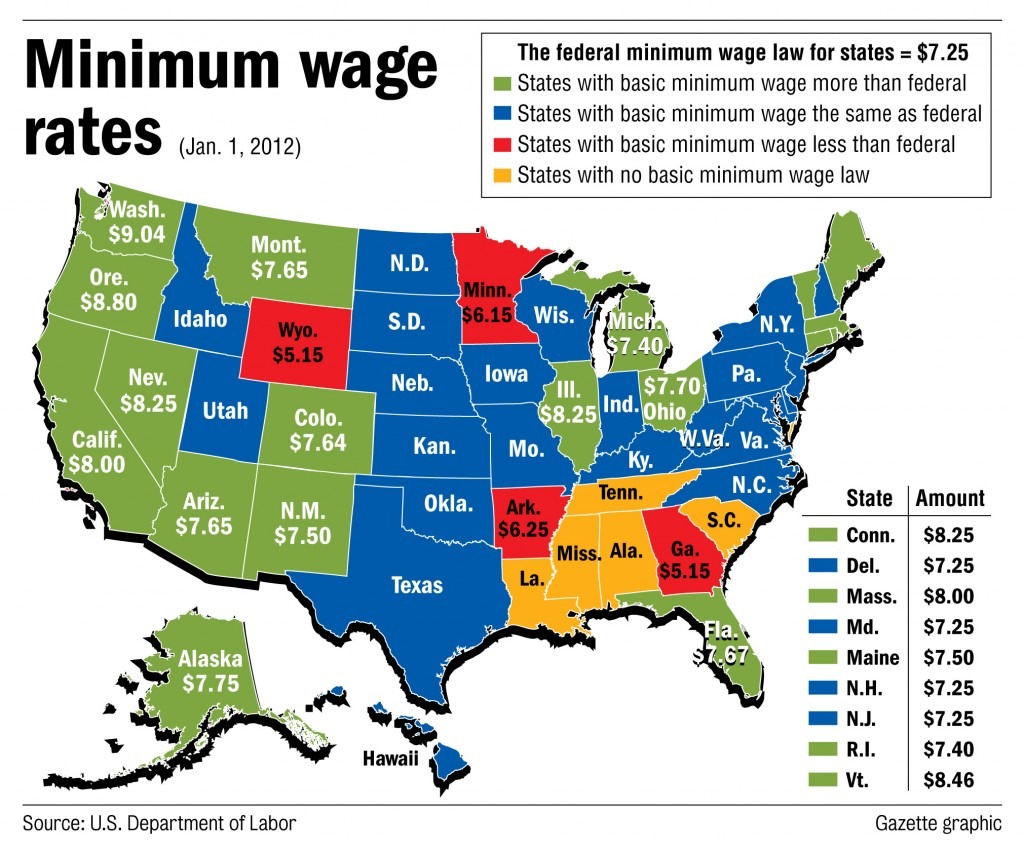 (Source: The Gazette)
(Source: The Gazette)
Back when I first studied economics, we “proved” in class that a minimum wage causes unemployment. You just draw supply and demand curves for labor, add a horizontal line for a wage above the “market clearing” competitive equilibrium wage, and—bingo!—a gap appears between labor supply and labor demand.
| Employers routinely violate current minimum wages, federal and state. They pay for fewer hours than employees work, or dip into restaurant workers’ tips. |
I took this orthodoxy on faith until 1992. That’s when David Card and Alan Krueger’s famous paper “Minimum Wages and Employment” appeared, comparing unemployment among fast food workers in New Jersey and Pennsylvania before and after New Jersey raised the minimum wage.
Card and Krueger found no effect. None. Zip. At first I shared the economics profession’s incredulity. The research was sloppy. The sample was too small. The researchers’ liberal bias skewed the results. Why even waste time testing something obvious? But then more studies came out, some also showing no effect, and some showing a small positive effect.
An explanation also began to emerge, in terms of the “efficiency wage hypothesis,” developed among others by our new Federal Reserve chairwoman Janet Yellen. Instead of there being a single “market” wage for unskilled labor, there is a market wage range. The higher the wage an establishment pays relative to other firms, the more diligent and loyal its employees, and the less likely they are to quit. So up to a point, the establishment saves on supervision and training costs what it loses in higher wages. Thus there’s nothing remarkable about the fact that Costco remains profitable while paying substantially higher wages than low-wage super-stores like Walmart. The efficiency wage hypothesis supports a cautious case that setting a minimum wage toward the top of the wage range will benefit workers without harming employers. (Needless to say, conservatives do not buy this argument.)
But there’s still a piece of the story missing.
The original supply and demand model I learned in my Econ 101 textbook assumed a perfectly competitive market—as do all introductory textbooks. There may be a chapter on monopoly toward the end, but the instructor rarely gets to it. That’s perverse, as most businesses have some degree of monopoly power—including your local grocery store, just because it’s closer to you than competitors. Some businesses, like Walmart or Amazon, have substantial monopoly power.
What do we learn in the monopoly chapter if we get to it? We learn that monopolists—sole sellers—reduce production in order to drive up prices. Monopsonists—sole buyers—hold back purchases of inputs to squeeze their suppliers. Inputs like labor. Hmm. Where have we heard this story? Ah, company towns, like coal towns in Appalachia.
It follows that big low-wage employers like Walmart may rationally follow a strategy of paying as little as they can, holding down employment in order to push down the market wage range. Such a low-wage strategy offers them an additional advantage: the resulting high turnover of employees makes unionization more difficult. Do big employers collaborate in this strategy? The U.S. Justice Department just caught the CEO’s of Apple, Intel, Google, Adobe, Intuit, and Pixar conspiring to hold down wages for programmers. Walmart and other big low-wage employers don’t need a conspiracy; a tacit understanding will do.
But if the big low-wage employers drive down the whole wage range, then surely the answer is to set a minimum wage even higher than the top of that range, higher than that suggested by the efficiency wage hypothesis.
Maybe much higher.
Moreover, such a wage increase should actually create jobs, by countering the low-wage strategy. How would that work? Big low-wage employers squeeze employees by deliberately staying understaffed, relying on mandatory overtime as needed. A forced wage increase creates jobs by taking away the gain from understaffing. Holy cow! Talk about turning Econ 101 on its head!
So what’s the fly in the ointment? Enforcement.
Employers routinely violate current minimum wages, federal and state. They pay for fewer hours than employees work, or dip into restaurant workers’ tips. My son is a restaurant worker; I clench my teeth thinking of how his bosses have taken advantage of him, for example sending him to make deliveries and pick up supplies in his own car, without reimbursing his expenses.
Enforcement. A big increase in minimum wages makes a hollow victory without enforcement. Enforcement is what unions do through grievance procedures, when there are unions. We’re unlikely to get effective unions without a parallel effort to enforce anti-trust laws and undo tax and regulatory policies rigged in favor of the big boys. But at least we can toss out the old textbook argument that raising the minimum wage causes unemployment.
Polly Cleveland is Adjunct Professor of Environmental Economics at Columbia University School of International and Public Affairs. This originally appeared in different form in Dollars & Sense.


0 Comments